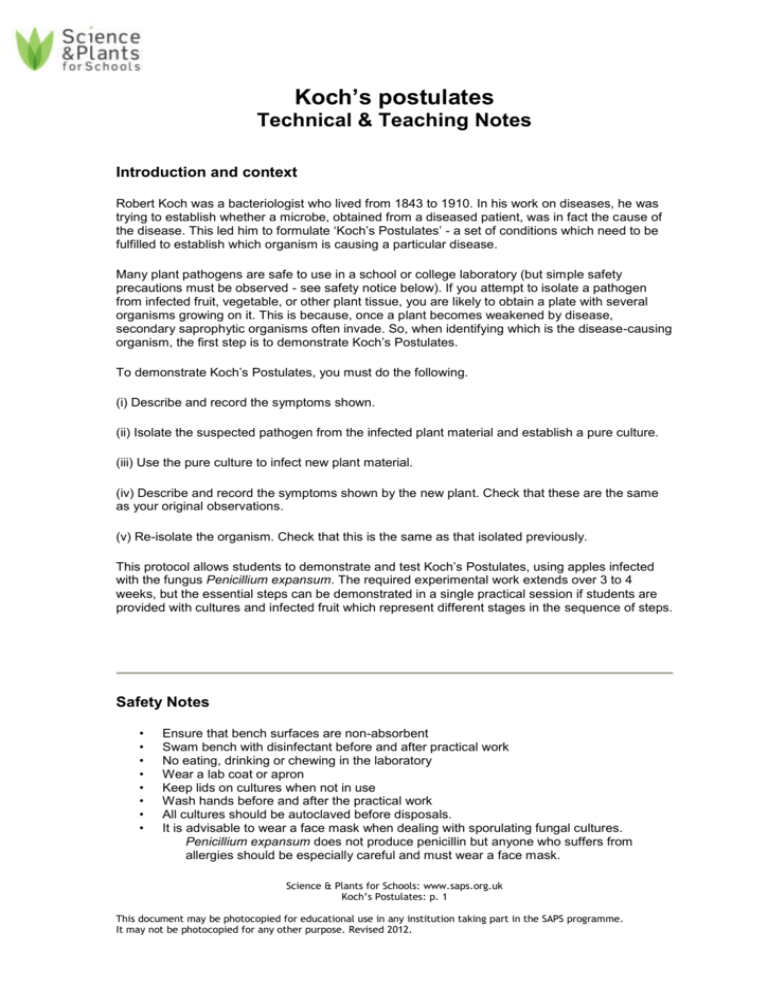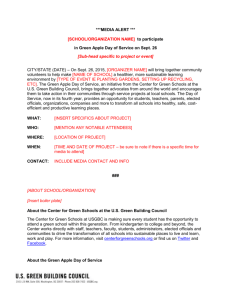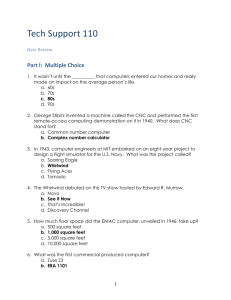Koch`s Postulates - teacher notes
advertisement

Koch’s postulates Technical & Teaching Notes Introduction and context Robert Koch was a bacteriologist who lived from 1843 to 1910. In his work on diseases, he was trying to establish whether a microbe, obtained from a diseased patient, was in fact the cause of the disease. This led him to formulate ‘Koch’s Postulates’ - a set of conditions which need to be fulfilled to establish which organism is causing a particular disease. Many plant pathogens are safe to use in a school or college laboratory (but simple safety precautions must be observed - see safety notice below). If you attempt to isolate a pathogen from infected fruit, vegetable, or other plant tissue, you are likely to obtain a plate with several organisms growing on it. This is because, once a plant becomes weakened by disease, secondary saprophytic organisms often invade. So, when identifying which is the disease-causing organism, the first step is to demonstrate Koch’s Postulates. To demonstrate Koch’s Postulates, you must do the following. (i) Describe and record the symptoms shown. (ii) Isolate the suspected pathogen from the infected plant material and establish a pure culture. (iii) Use the pure culture to infect new plant material. (iv) Describe and record the symptoms shown by the new plant. Check that these are the same as your original observations. (v) Re-isolate the organism. Check that this is the same as that isolated previously. This protocol allows students to demonstrate and test Koch’s Postulates, using apples infected with the fungus Penicillium expansum. The required experimental work extends over 3 to 4 weeks, but the essential steps can be demonstrated in a single practical session if students are provided with cultures and infected fruit which represent different stages in the sequence of steps. Safety Notes • • • • • • • • Ensure that bench surfaces are non-absorbent Swam bench with disinfectant before and after practical work No eating, drinking or chewing in the laboratory Wear a lab coat or apron Keep lids on cultures when not in use Wash hands before and after the practical work All cultures should be autoclaved before disposals. It is advisable to wear a face mask when dealing with sporulating fungal cultures. Penicillium expansum does not produce penicillin but anyone who suffers from allergies should be especially careful and must wear a face mask. Science & Plants for Schools: www.saps.org.uk Koch’s Postulates: p. 1 This document may be photocopied for educational use in any institution taking part in the SAPS programme. It may not be photocopied for any other purpose. Revised 2012. Apparatus Per group • • • • Apple 1 – wounded and inoculated 7 days previously with Penicillium expansum Apple 2 – ‘control’ apple – on one side this is wounded and inoculated with sterile distilled water, on the other side a fungal culture is applied to the intact skin (without wounding) Apples 3 and 4 – fresh apples to inoculate One Petri dish (plate) with a 7-day culture of Penicillium on malt agar • • • • • • Two clean malt agar plates micropore tape scalpel Bunsen burner methylated spirits ruler Preparation for the practical work. Agar plates and apples need to be inoculated about one week before the first practical session and incubated at 20 to 25 degrees C. When inoculating agar plates from infected apples, it is best to push the piece of infected tissue right into the agar jelly in the centre of the plate. Plates should be inoculated the right way up so need to be poured in a way that gives very little condensation. Instructions 1. Examine the fungal colony on the agar plate. Describe its appearance. Note colour, appearance and diameter of colonies. 2. Examine the infected apple (externally). Compare with the control. Apple 1 has been inoculated with Penicillium. Apple 2 is the control (see above) Note colour, shape, texture and size of infection. 3. Examine the infected apple (internally). Compare with the control. Cut the infected and the control apples in half, through the inoculation point. Describe the type of rot you see. Note colour, texture and size of infection. 4. Isolate the organism from the infected material (apple 1) and transfer to culture on a plate. Flame and cool the blade of a scalpel. Cut out a small piece (5mm x 5mm) of infected tissue from the cut surface of the infected apple. Place this in the centre of a clean malt agar plate. Replace lid, seal with tape and label. Repeat for apple 2 (control). Incubate plates,the right way up, at 25 degrees C for 7 days. 5. After 7 days you should have one of more fungal colonies on your plate. Infect a new apple using the culture on the plate (from step 4). Flame scalpel (or forceps) and cool. Make a wound in a fresh apple (apple 3) and insect a small piece of fungal colony from the agar plate. Cover wound with micropore tape. Label. Incubate at room temperature for 7 days. 6. Repeat step 5 using the fungal colony (if any) from the control apple. Examine each day for 7 days. Record your results in a table as before. Are your observations the same as you recorded earlier? Science & Plants for Schools: www.saps.org.uk Koch’s Postulates: p. 2 This document may be photocopied for educational use in any institution taking part in the SAPS programme. It may not be photocopied for any other purpose. Revised 2012. Now check through to see if you have demonstrated Koch’s Postulates (see statements below). If your answers to numbers (iv) and (v) are ‘yes’, then you have isolated the organism which is causing the disease. Acknowledgements Acknowledgements to Dr Mary MacDonald and Sue Hocking (Trowbridge College). Science & Plants for Schools: www.saps.org.uk Koch’s Postulates: p. 3 This document may be photocopied for educational use in any institution taking part in the SAPS programme. It may not be photocopied for any other purpose. Revised 2012.





